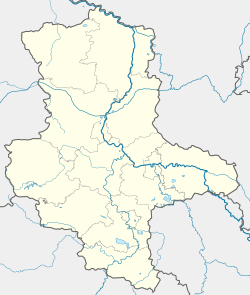world.wikisort.org - Germany
Jessen (German pronunciation: [ˈjɛsn̩] (![]() listen)) is a municipality on the Black Elster river and lies in the eastern part of Saxony-Anhalt in the district of Wittenberg.
listen)) is a municipality on the Black Elster river and lies in the eastern part of Saxony-Anhalt in the district of Wittenberg.
Jessen | |
|---|---|
Town | |
 | |
 Coat of arms | |
Location of Jessen (Elster) within Wittenberg district  | |
 Jessen  Jessen | |
| Coordinates: 51°47′30″N 12°57′20″E | |
| Country | Germany |
| State | Saxony-Anhalt |
| District | Wittenberg |
| Government | |
| • Mayor (2021–28) | Michael Jahn[1] |
| Area | |
| • Total | 351.94 km2 (135.88 sq mi) |
| Elevation | 72 m (236 ft) |
| Population (2020-12-31)[2] | |
| • Total | 14,074 |
| • Density | 40/km2 (100/sq mi) |
| Time zone | UTC+01:00 (CET) |
| • Summer (DST) | UTC+02:00 (CEST) |
| Postal codes | 06917, 06918, 06926, 06928 |
| Dialling codes | 03537, 035387, 035389 |
| Vehicle registration | WB, GHC, JE |
| Website | www.jessen.de |
Geography
Jessen is an amalgamated municipality, and has the following 44 subdivisions (Ortsteile):[3]
- Arnsdorf
- Battin
- Buschkuhnsdorf
- Dixförda
- Düßnitz
- Gentha
- Gerbisbach
- Glücksburg
- Gorsdorf
- Grabo
- Großkorga
- Hemsendorf
- Holzdorf
- Jessen (Elster)
- Kleindröben
- Kleinkorga
- Klöden
- Klossa
- Kremitz
- Leipa
- Linda
- Lindwerder
- Lüttchenseyda
- Mark Friedersdorf
- Mark Zwuschen
- Mauken
- Mellnitz
- Mönchenhöfe
- Morxdorf
- Mügeln
- Naundorf
- Neuerstadt
- Rade
- Rehain
- Reicho
- Rettig
- Ruhlsdorf
- Schadewalde
- Schöneicho
- Schützberg
- Schweinitz
- Seyda
- Steinsdorf
- Zwuschen
History
The first documentary evidence of Jessen's existence dates to 1217. On the night of 20 to 21 September 1729, much of the town was destroyed in a fire. After belonging to Saxony for centuries, Jessen became Prussian in 1816.
In 1945, it became part of the state of Saxony-Anhalt. In 1952, owing to East German administrative reforms, Jessen became a district capital in the Cottbus region (Cottbus is nowadays in Brandenburg). In 1990, Jessen once again became part of the newly-refounded state of Saxony-Anhalt. In 1992 came the amalgamation of the communities of Grabo, Gorsdorf-Hemsendorf, Lindwerder and Großkorga, and in 1993, Schweinitz, Gerbisbach, Klossa, Schöneicho, Steinsdorf and Dixförda. With the district reform in 1994, Jessen became part of Wittenberg district, as well as having a further three communities melded with it, namely Battin, Düßnitz and Kleindröben-Mauken. In 1999 came further amalgamations: Arnsdorf, Leipa and Ruhlsdorf mit Rehain. On 1 March 2004 came a further 12, among them Seyda, Holzdorf and Linda (Elster). Some of these formerly independent communities themselves each consisted of more than one centre, and so Jessen now has a total of 47 Stadtteile (constituent communities).
Economy and infrastructure
Established businesses are mostly small and mid-sized concerns in metalworking, building, dairy processing and drink production. There are also, however, bigger enterprises in agriculture.
Culture and Sightseeing

- Historic marketplace in Jessen
- Parish church of St. Nicolai in Jessen
- Schloss Jessen (stately home), since 1999 town council seat
- Parish church of St. Marien in Schweinitz
- Amtshaus in Schweinitz
- Gorsdorf village church
- Kleindröben village church
- Pretzsch-Mauken reaction ferry
Personalities
- Karl Lamprecht (25 February 1856 – 10 May 1915 in Leipzig), was Professor of History at the University of Leipzig, who is known today mainly for his rôle in the Methodenstreit.
- Herbert Kaiser (16 March 1916 – 5 December 2003) a pilot in the Luftwaffe during World War II
Sundry
The town is Germany's twelfth-largest municipality by land area, and is thereby about 3 km² bigger than Munich.
References
- Bürgermeisterwahlen in den Gemeinden, Endgültige Ergebnisse, Statistisches Landesamt Sachsen-Anhalt, accessed 3 February 2022.
- "Bevölkerung der Gemeinden – Stand: 31. Dezember 2020" (PDF). Statistisches Landesamt Sachsen-Anhalt (in German). June 2021.
- Hauptsatzung der Stadt Jessen (Elster), 2 July 2019.
External links
На других языках
[de] Jessen (Elster)
Jessen (Elster) ist eine Stadt an der Schwarzen Elster und liegt im östlichen Teil von Sachsen-Anhalt im Landkreis Wittenberg. Sie gehört mit ihrer Fläche von rund 352 km² zu den flächengrößten Städten in Deutschland. Sie besteht aus 44 Ortsteilen mit Jessen als dem größten und namensgebenden Ort.- [en] Jessen (Elster)
[ru] Йессен
Йессен (нем. Jessen) — город в Германии, в земле Саксония-Анхальт.Другой контент может иметь иную лицензию. Перед использованием материалов сайта WikiSort.org внимательно изучите правила лицензирования конкретных элементов наполнения сайта.
WikiSort.org - проект по пересортировке и дополнению контента Википедии
